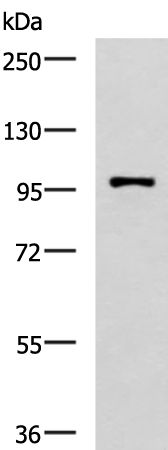


| WB | 咨询技术 | Human,Mouse,Rat |
| IF | 咨询技术 | Human,Mouse,Rat |
| IHC | 1/20-1/100 | Human,Mouse,Rat |
| ICC | 技术咨询 | Human,Mouse,Rat |
| FCM | 咨询技术 | Human,Mouse,Rat |
| Elisa | 1/5000-1/10000 | Human,Mouse,Rat |
| Aliases | IMF2; LMNS; CASIL; CADASIL; CADASIL1 |
| WB Predicted band size | 244 kDa |
| Host/Isotype | Rabbit IgG |
| Antibody Type | Primary antibody |
| Storage | Store at 4°C short term. Aliquot and store at -20°C long term. Avoid freeze/thaw cycles. |
| Species Reactivity | Human, Mouse, Rat |
| Immunogen | Synthetic peptide of human NOTCH3 |
| Formulation | Purified antibody in PBS with 0.05% sodium azide and 50% glycerol. |
+ +
以下是3篇关于NOTCH3抗体的代表性文献及其摘要概括:
1. **《NOTCH3 mutations in cerebral autosomal dominant arteriopathy with subcortical infarcts and leukoencephalopathy (CADASIL)》**
*作者:Joutel A et al. (1996)*
摘要:首次发现NOTCH3基因突变与CADASIL的关联,建立了特异性抗体检测突变蛋白在血管平滑肌细胞中的异常聚集,为病理诊断奠定基础。
2. **《The ectodomain of the Notch3 receptor accumulates within the cerebrovasculature of CADASIL patients》**
*作者:Joutel A et al. (2000)*
摘要:通过开发针对NOTCH3细胞外结构域的单克隆抗体,证实CADASIL患者脑血管中突变NOTCH3蛋白的异常沉积,揭示疾病特异性病理标志。
3. **《Diagnostic value of skin biopsy in cerebral autosomal dominant arteriopathy with subcortical infarcts and leukoencephalopathy》**
*作者:Rutten JW et al. (2016)*
摘要:提出使用NOTCH3抗体进行皮肤活检免疫组化检测,作为CADASIL的无创诊断方法,特异性识别血管壁中的颗粒状嗜锇物质(GOM)。
4. **《Cysteine-altering NOTCH3 variants are a risk factor for stroke in the elderly population》**
*作者:Chabriat H et al. (2020)*
摘要:利用NOTCH3抗体对老年卒中患者进行病理分析,发现非典型NOTCH3变异与脑血管病变相关,扩展了抗体在散发性脑血管病研究中的应用。
NOTCH3 antibodies are tools used to study the NOTCH3 protein, a transmembrane receptor crucial for cell-cell signaling and vascular homeostasis. NOTCH3 is predominantly expressed in vascular smooth muscle cells (VSMCs) and pericytes, where it regulates cell differentiation, proliferation, and survival. Mutations in the NOTCH3 gene are linked to cerebral autosomal dominant arteriopathy with subcortical infarcts and leukoencephalopathy (CADASIL), a hereditary stroke disorder characterized by VSMC degeneration, cerebral small vessel pathology, and cognitive decline. These mutations often affect epidermal growth factor-like (EGF) repeats in the extracellular domain, leading to protein aggregation and vascular dysfunction.
NOTCH3 antibodies target specific regions of the protein, such as the extracellular EGF repeats or intracellular domains, enabling researchers to detect expression levels, localization, or pathological aggregates in tissues or cell models. They are widely used in immunohistochemistry, Western blotting, and immunofluorescence to investigate NOTCH3-related mechanisms in CADASIL and other vascular or neurodegenerative diseases. Additionally, these antibodies aid in developing diagnostic assays and exploring therapeutic strategies, such as blocking abnormal signaling or clearing toxic protein deposits. Recent studies also explore NOTCH3's role beyond CADASIL, including cancer and age-related vascular disorders, highlighting its broader implications in cellular signaling pathways.
×